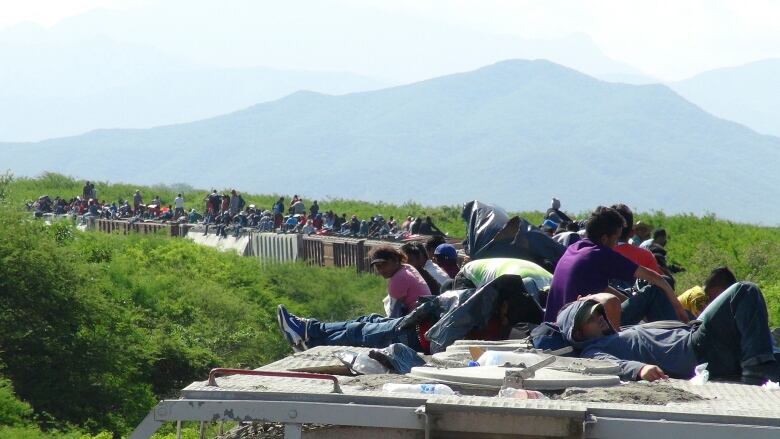Refugees from Central America a humanitarian crisis on Canada's doorstep, says aid agency
Canada asked to make asylum easier for refugees fleeing from violence

Doctors Without Borders says the Liberal government must do something about the humanitarian crisis on its doorstep by making asylum easier for refugees fleeing the northern triangle of Central America.
The aid group says an estimated 500,000 people from Honduras, El Salvador and Guatemala flee into Mexico every year from the three violence-plagued countries, where rates of murder, kidnapping and sexual violence are comparable to those in full-blown war zones.
However, people escaping the region have long been painted as economic migrants by countries of refuge, including Canada, says the group, widely known by its French name, Médecins Sans Frontières, or MSF.
- Migrants wait in limbo, hoping for sanctuary in Canada
- Refugee claims at Canada-U.S. border have doubled
A report released by MSF on Thursday draws on comprehensive medical data gathered by MSF teams on the ground in Mexico. Nearly 40 per cent of interviewed migrants from Honduras, El Salvador and Guatemala treated in MSF clinics in Mexico cited "direct attacks or threats to themselves or their families, extortion, or gang-forced recruitment as the main reasons for fleeing their countries."
Of the refugees and migrants surveyed, nearly half had a relative who had been killed due to violence in the previous two years.
Canada must urgently rethink its approach to immigration from the region, including formal resettlement, said Jason Cone, executive director of MSF USA, who is calling the policies of refuge countries such as Canada and the United States as "wholly inefficient to the gravity of the situation."
"While the dynamics are different, [the situation in Central America] is not dissimilar from the kind of forced migration I have seen working for this organization in the Middle East, or in places like South Sudan," says Cone.
In 2016, 87 of the 136 Hondurans who applied were granted refugee protection in Canada, a 62 per cent acceptance rate; 21 of the 51 Guatemalans who applied were accepted, a 34 per cent acceptance rate; and 152 of the 244 applicants from El Salvador were accepted, a 71 per cent acceptance rate, according to statistics provided by the Immigration and Refugee Board of Canada.

A decrease in the number of people requesting refugee protection from the three countries since a peak in 2008 reflects the many barriers that prevent them from accessing the asylum system, says Jamie Liew, an expert in immigration and refugee law with the University of Ottawa.
For example, many migrants face systematic forced repatriation from Mexico back to their home countries in Central America, often within less than 36 hours of arriving in the country. It is a violation of basic refugee protections that makes it unlikely they ever file an official request for refugee protection, says MSF Mexico field co-ordinator Takos Vasilis.
And those hoping to reach Canada in the most economical way possible, by land, are prevented from applying for protection in Canada because of the Safe Third Country Agreement between Canada and the U.S., which requires refugee claimants to request protection in the first safe country they arrive in.
Policies such as these drive refugees from the northern triangle of Central America into the arms of traffickers and human smugglers, says MSF.
Extreme violence on migration route
For millions of people from Honduras, El Salvador and Guatemala, trauma, fear and horrific violence are dominant facets of daily life, MSF says, but the "reality is that does not end with their forced flight to Mexico."
Once fleeing their home countries, the MSF report says, nearly 70 per cent of the migrant and refugee populations entering Mexico reported being victims of violence during their transit north, from members of gangs and other criminal organizations as well as the Mexican security forces responsible for their protection.
"Along the migration route … migrants and refugees are preyed upon by criminal organizations, sometimes with the tacit approval or complicity of national authorities, and subjected to violence and other abuses, abduction, theft, extortion, torture, and rape, that can leave them injured and traumatized," states the report.

Nearly one-third of women surveyed said they had been sexually abused during their journey. Women and girls go so far as to seek access to birth control medication before their journeys, as the expectation of being raped or to have to perform transactional sex for food or shelter is so high, says MSF USA executive director Jason Cone.
Nearly one in 10 migrants interviewed by MSF teams in Mexico reported symptoms of post-traumatic stress disorder, a rate comparable to that of populations affected by direct conflict.
African, Middle Eastern refugees turning to Central American corridor
While the vast majority of migrants fleeing to Mexico are from Central America, MSF says in a press conference released Thursday that the Central American migration corridor is increasingly being used by refugees from Africa and the Middle East to reach the U.S. and Canada.
Hostels in Mexico, which provide food and shelter to refugees attempting to cross Mexico, are reporting that they are hosting migrants from up to 20 to 30 different countries at a time, says MSF Mexico field co-ordinator Vasilis.
In February, CBC News interviewed more than two dozen migrants from Somalia, Ghana, Guinea-Bissau, Ethiopia, Eritrea, India, Bangladesh, Nepal and Yemen in Mexico City and Tapachula, on the Mexico-Guatemala border.
Many of the overseas migrants who could not get a direct visa for Canada flew into a South or Central American country to begin their overland journey north.
Once across the Atlantic they travel, often by foot, through Peru, Ecuador, Colombia, Panama, Costa Rica, Nicaragua, Honduras, Guatemala and Mexico with the goal of claiming asylum in the U.S. or Canada.